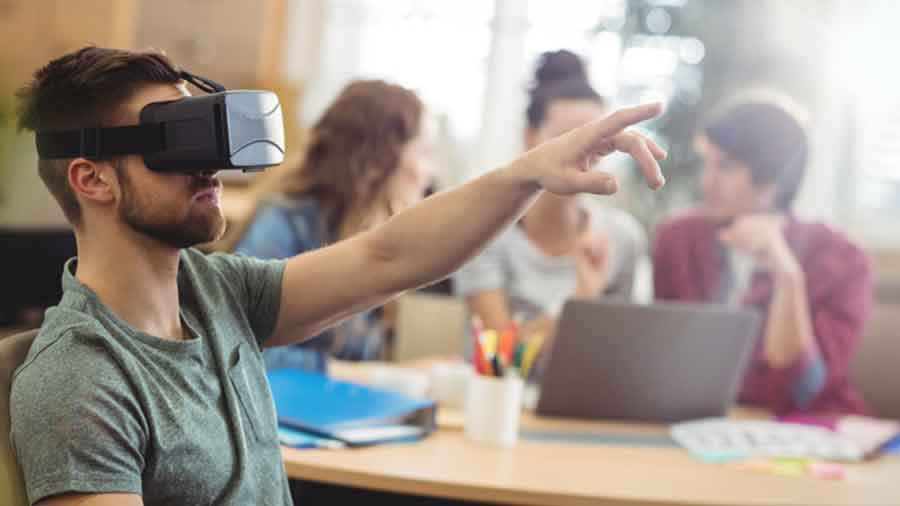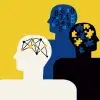Imagine that you turn into a cat and your goal is to catch a canary. To do so, you need to use speed calculation formulas and Newton’s laws of motion.
This is how high school students at Tec de Monterrey learn Physics concepts: by playing games and solving problems in a virtual reality environment.
Hugo Santos, teacher at PrepaTec Garza Lagüera, and Rocío Cortez, high school academic coordinator for Digital Education, explain how this technology is used.
“The name of the resource is ‘Catch me if you can’ and there are 3 challenges in which students assign values and do calculations so that the cat can catch the bird,” explains Cortez.
This activity forms part of the online post-theory practical course “Energy and Transformation“ which is taught by Professor Santos.

Playing “Catch me if you can” to learn Physics
In the activity, students are presented with different equations, each of which must be solved in order to continue to the next challenge. Students do this until they complete all 3, all the while being able to see the virtual world in 360 degrees from any angle.
“They (the characters) are on a street and when the bird flies past, the cat must cross the street and climb a ladder,” adds Santos.
“The kids assign values such as speed, distance, and time elapsed. Then they confirm their result,” says Cortez.
“The name of the resource is ‘Catch me if you can’ and there are 3 challenges in which students assign values and do calculations.” - Rocío Cortez
Virtual reality (VR) is immersion in a digital simulation by using headsets. Users can manipulate objects, have meetings, interact with the environment, and consolidate their subject knowledge and skills.
This technology enables individual and collaborative experiences. Students can enter this virtual world using a computer or cellphone by following a link that is sent during class.
“It’s a digital space where students can have an immersive experience using their computer or 3D glasses. It focuses the interest of the students and makes the course more fun and more impactful,” she adds.
The benefits of virtual reality: more motivated students
The teacher notes that one of the benefits he has seen in class is that students feel more motivated and can better understand concepts as a result of using theory in hands-on experiments.
“When students start to use it, they start to see it as a video game, and they tell us that it looks like this one or that one,” Santos shared.
“We force them out of their comfort zone. As it’s an online course, they think that they’ll just see the teacher, but they don’t imagine that they’ll be able to enter an immersive world,” adds Cortez.
Other benefits include improved attention spans, better memory, and personalized learning.
Different learning processes used by virtual reality courses include problem solving, games, submitting portfolios, self-evaluations, co-evaluations, and automatic feedback, according to a Tec de Monterrey EduTrends report.
“When students start to use it, they start to see it as a video game, and they tell us that it looks like this one or that one.” - Hugo Santos
Challenges of this type of technology
The teacher points out that most students adapt to change and the use of technology, so teachers should try to apply it in their classes.
“Sometimes, we’re stuck in 2D and we don’t want to take any risks, but we must become facilitators of knowledge and let students experiment, discover, practice, and find out their own answers,” he explains.
“Our dream is that this can be developed and applied across various subjects. There should be more resources, more facilities, and more teachers to bring this experience to life,” he adds.
The challenges that the EduTrends publication notes in providing this type of course include:
- It’s expensive to create an immersive experience.
- Collecting and maintaining information about everything that is needed takes a lot of time and effort.
- The technology for creating these experiences is new and experimental.
- Learning in a VR environment doesn’t have the same effects as learning in the real world.
- It requires a very high data processing speed.
For Tecnológico de Monterrey, augmented reality and virtual reality improve the learning experience by using digital elements that facilitate interaction with situations that are often difficult to access in the real world.
This technology is part of the immersive innovation that has taken place at the Tec since 2018:
- 442 teachers
- 21,760 students
- 223 subjects

The goal: create a virtual learning “amusement park”
Professor Santos points out that a medium-term goal is to create a virtual “amusement park” to teach students about energy and transformation concepts.
“We’re taking baby steps now but, in a few years, we’ll be running,” he says, smiling.
Although it has already been used in classes during the semester, the professor explains that it’s still a work in progress and that they will continue to develop new ideas and activities within the virtual world they have named “Tec City.”
“The project isn’t finished. It’s designed to teach Physics, but it could be expanded. Joking with the designers, I told them that this is just the beginning.
“We’re going to use vehicles for an acceleration and displacement topic and then there’ll be a gym where we can look at Newton’s laws of motion and topics like force and power,” he says.
Cortez explains that they approached the Educational Innovation and Digital Learning department in order to carry out the project. They designed the course alongside Professor Santos who was the person in charge of the pedagogical aspects.
“It had been used in other subjects. When we were designing (the course), they showed me their work and I remember telling them that I was really interested,” says Santos.

Not the first project to use virtual reality
Cortez points out that they’re not the first to use this technology, which was developed by the Educational Innovation and Digital Learning department. She points out that it had already been used in other semesters and courses at PrepaTec .
There is a virtual supermarket where nutrition students learn to select healthy products and a virtual museum where students exhibited and viewed their works as part of a film class.
“The students learned about healthy food through the visit to the supermarket where they could select products for a balanced diet, as well as a virtual gallery where were modified movie posters were displayed,” says Cortez.
She also shares that one of her dreams is to create a fully immersive course so she can evaluate the long-term results of its effectiveness compared to traditional courses.
“It could be the future of an immersive education where students learn through virtual reality.”
“I don’t know if time will prove me right, but meanwhile we’ll continue to develop this type of project. I think it will have been worth it if other teachers were encouraged and contacted me,” concludes Santos.
READ MORE AT:





